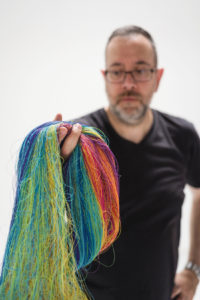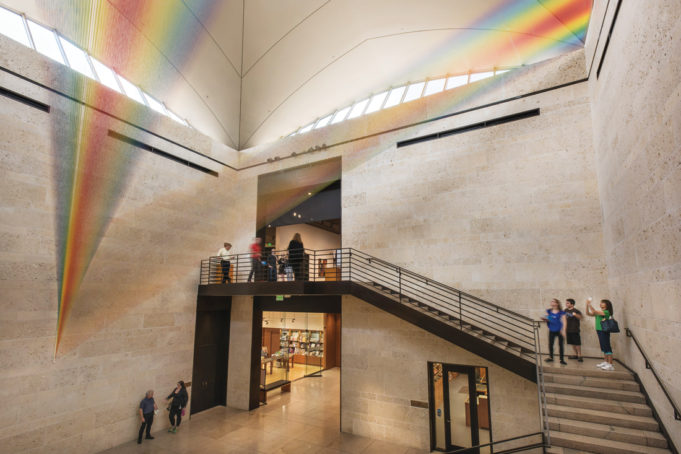The main atrium of the Amon Carter Museum of American Art was completed 15 years ago this October as part of the museum’s expansion. To mark the occasion, the museum wanted to do something more imaginative than place a large canvas on the wall. The resulting commissioned installation by Gabriel Dawe is much better, and you can see it until 2018.
Speaking at a press preview, the Mexican-born artist spoke about the macho culture he was raised in. “My grandmother taught my sister how to embroider, and I wanted to learn, too,” he said. “But she wouldn’t teach me.” He eventually did learn, and while he took a detour to work as a graphic artist for seven years in Montreal, it brought him to UT-Dallas and a residency at CentralTrak. He had visited the Amon Carter on numerous occasions before the museum asked him to create a work for its space, and he was happy to oblige.
His latest work at the Amon Carter is entitled Plexus No. 34, and it’s the latest in a series of installations built out of Gütermann polyester thread strung on hooks and stretched through architectural spaces. Sometimes they are limited to a few shades, but more often they are like No. 34 and use all the colors of the visible spectrum — Dawe says he dislikes the term “rainbow.” Previous iterations of the Plexus series have been installed in places as far away as Hellerup, Denmark and Como, Italy, though more recent ones have been closer to home like the Crystal Bridges Museum in Bentonville, Ark., and the Renwick Gallery in Washington, D.C., which is part of the Smithsonian Institute.
No. 34 radiates from a vertical frame that’s been placed approximately 10 feet up on the wall opposite the main staircase. From there, approximately 80 miles of colored thread stretch in two directions up to various anchoring points by the windows above the staircase, with the threads twisting to provide a three-dimensional aspect to the work. Seen from directly below, the colors of the thread blur together to create the effect of a rainbow bridge streaming in from the windows. The look of the piece also changes under different lighting conditions and at different times of day, and the multiple landings on the staircase afford a number of different viewpoints to see the work. Personally, I found the most compelling vantage point to be the entrances to the galleries at the top of the staircase, where you can gaze straight into the mass of threads and see the colors diffuse and completely fill your field of vision. If you do get tired of staring at the piece, you can always divert your gaze down to the people walking into the atrium and getting their first glimpse of it.

Unusually, the museum has released a Spotify playlist to go with the work, which is mostly made up of songs that refer to colors, ranging from Gershwin’s Rhapsody in Blue to Explosions in the Sky’s “Colors in Space.” (What, no “Purple Haze”?) The interior of the Carter was designed by Philip Johnson as a space where the cream-colored shellstone walls would not detract from the art that would adorn it. By infusing the airspace with a great splash of color, Gabriel Dawe makes us take a second look at an atrium that can look forbiddingly plain. The museum’s new look demands to be seen for its inspiring qualities and its uncomplicated beauty.
[box_info]Gabriel Dawe: Plexus No. 34
Thru Sep 2, 2018. Amon Carter Museum of American Art, 3501 Camp Bowie Blvd, FW. Free. 817-738-1938.[/box_info]












